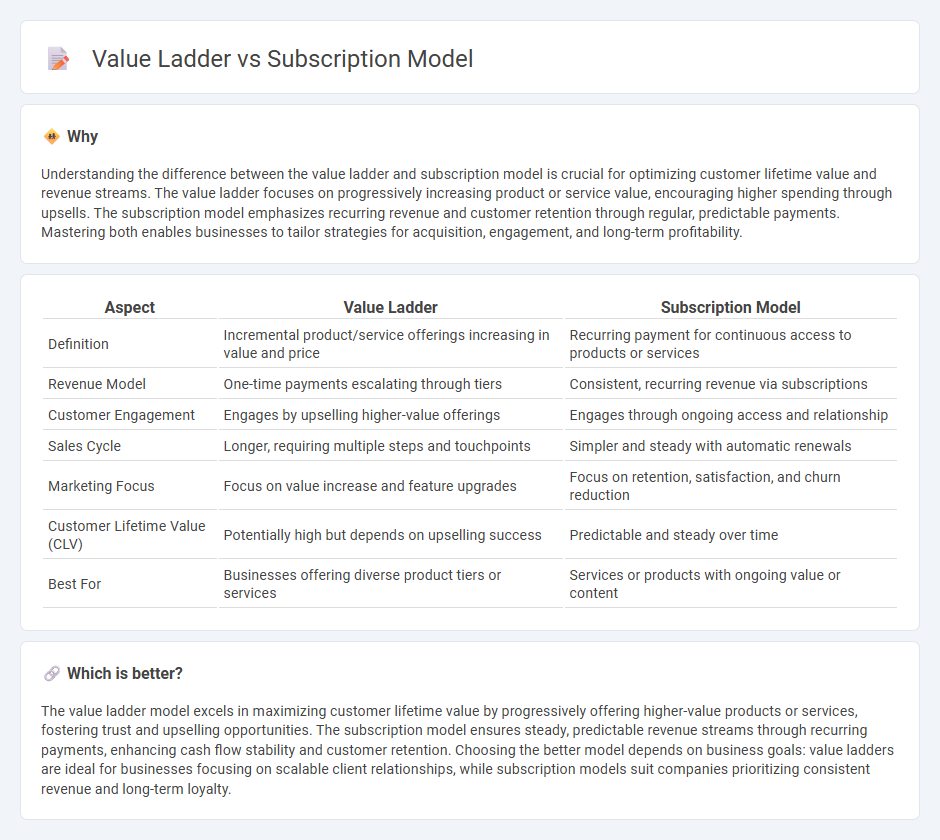
Sales strategies often compare the value ladder approach, which gradually increases customer investment through a sequence of offers, with the subscription model that generates consistent revenue via recurring payments. The value ladder builds trust and maximizes lifetime customer value by progressively introducing higher-priced products or services, while subscription models emphasize customer retention and predictable cash flow. Discover how these distinct sales frameworks can optimize your business growth and revenue streams.
Why it is important
Understanding the difference between the value ladder and subscription model is crucial for optimizing customer lifetime value and revenue streams. The value ladder focuses on progressively increasing product or service value, encouraging higher spending through upsells. The subscription model emphasizes recurring revenue and customer retention through regular, predictable payments. Mastering both enables businesses to tailor strategies for acquisition, engagement, and long-term profitability.
Comparison Table
| Aspect | Value Ladder | Subscription Model |
|---|---|---|
| Definition | Incremental product/service offerings increasing in value and price | Recurring payment for continuous access to products or services |
| Revenue Model | One-time payments escalating through tiers | Consistent, recurring revenue via subscriptions |
| Customer Engagement | Engages by upselling higher-value offerings | Engages through ongoing access and relationship |
| Sales Cycle | Longer, requiring multiple steps and touchpoints | Simpler and steady with automatic renewals |
| Marketing Focus | Focus on value increase and feature upgrades | Focus on retention, satisfaction, and churn reduction |
| Customer Lifetime Value (CLV) | Potentially high but depends on upselling success | Predictable and steady over time |
| Best For | Businesses offering diverse product tiers or services | Services or products with ongoing value or content |
Which is better?
The value ladder model excels in maximizing customer lifetime value by progressively offering higher-value products or services, fostering trust and upselling opportunities. The subscription model ensures steady, predictable revenue streams through recurring payments, enhancing cash flow stability and customer retention. Choosing the better model depends on business goals: value ladders are ideal for businesses focusing on scalable client relationships, while subscription models suit companies prioritizing consistent revenue and long-term loyalty.
Connection
The value ladder progressively increases customer engagement by offering higher-value products or services, guiding buyers through ascending price points. Subscription models complement this strategy by providing recurring revenue streams at various levels of the value ladder, enhancing customer retention and lifetime value. Combining these methods fosters sustainable growth by encouraging continuous purchases and upgrading within the subscription tiers.
Key Terms
Recurring Revenue
Subscription models ensure steady recurring revenue by charging customers regular fees for ongoing access to products or services, fostering customer loyalty and predictable cash flow. Value ladders progressively increase customer lifetime value through tiered offerings, encouraging upgrades and higher spending over time without immediate recurring commitments. Explore how leveraging each strategy can maximize your business's recurring revenue potential.
Tiered Pricing
Subscription model and value ladder both utilize tiered pricing to maximize customer retention and revenue. Tiered subscription pricing offers multiple service levels with escalating features and benefits, encouraging upgrades while maintaining predictable recurring income. Explore deeper insights on how tiered pricing strategies optimize customer lifetime value in various business models.
Customer Lifetime Value
The subscription model ensures steady revenue through recurring payments, enhancing Customer Lifetime Value (CLV) by promoting long-term engagement and predictable cash flow. In contrast, the value ladder strategy maximizes CLV by gradually increasing customer spend through progressively higher-value offers, fostering deeper brand relationships. Explore how these models can strategically boost your CLV and revenue growth.
Source and External Links
What's a Subscription Business Model & How Does It Work? - A subscription business model is a recurring revenue model where customers pay a weekly, monthly, or yearly fee for access to products or services, with options to renew or cancel, enabling steady income and customer retention.
Subscription Business Model: The Future of Commerce | Recurly - This model centers on recurring payments for ongoing access, requiring strategies for customer acquisition, automated billing, subscription management, and continuous product or content updates to maintain long-term subscriber value.
Subscription business model - Wikipedia - The subscription model involves periodic recurring payments for product or service access, commonly used across multiple industries and including variants like freemium, tiered pricing, and usage-based billing to tailor offerings to customer needs.
 dowidth.com
dowidth.com